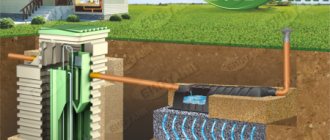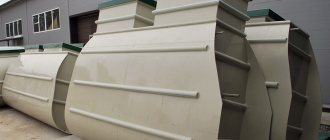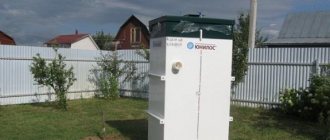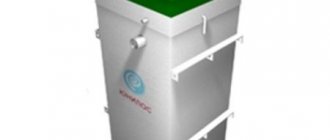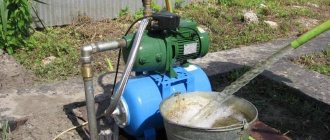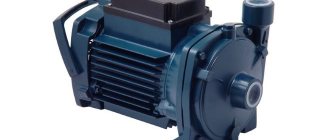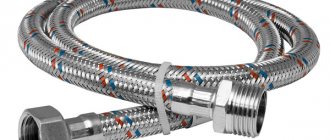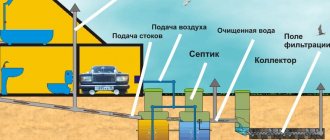The presence of an autonomous sewer system in a country house is one of the mandatory requirements that potential owners place on them. And this is correct - few people want to jump outside for natural needs when the temperature drops below -20...-30 degrees, and stays at this level for weeks. Therefore, many modern country houses have all the benefits of civilization. But many people have a completely reasonable question: “Will sewerage cause problems in winter?” It will be very useful to study this issue in as much detail as possible.
Operating a septic tank in winter
If the system works permanently, then there is nothing to be afraid of. Septic tanks operating in winter do not require additional heating or any special conditions. The fact is that constant drainage of wastewater at room temperature will prevent the system from freezing. The most important thing is not to open the lid in extreme cold, otherwise the liquid may freeze. The lid itself is already insulated and fits hermetically to the tank. There is no need to insulate it, since biomass, when decomposing, releases additional heat. In addition, the compressor operates permanently.
How will the septic tank work in winter if you come to the dacha only on weekends? Isn't it better to turn it off? No, because bacteria will only multiply with constant aeration (bubbling). To save money, you can install a special relay that periodically turns off the power. However, even systems for families of four to five people are not particularly expensive in terms of electricity.
Using sewerage elements in winter
It should be noted that with a significant decrease in ambient temperature, the plastic becomes more fragile. Therefore, the tanks and other elements of the system used should be handled with extreme caution; the possibility of mechanical impact must be excluded.
Articles on the topic
- How and why septic tanks are pumped out of cesspools, features of the sewerage system
- Selection of equipment for office ventilation, features of system design and operation
- Application of compressors for septic tank cleaning systems, modern filtration systems
- Purpose and principle of operation of plastic boxes for ventilation, types of devices
- The use of live bacteria for septic tanks and cesspools, features and advantages of operation...
Preservation of the septic tank
What to do with a septic tank in winter if you are not going to live in a country house during the cold season? It must be preserved without fail. The main disadvantage of preservation is that the spontaneous generation of bacteria in the spring will take from one to two weeks. Preservation instructions are included with each installation. The whole job will take you about an hour or two. If you don’t want to do it yourself, you can call specialists.
We list all the stages of conservation of volatile systems:
- disconnection from power supply. All biological treatment stations are energy dependent. They are turned off using a remote control or switches in the house. In some stations, you must first turn it off using a key located on the control unit of the installation.
- cleaning the system chambers from sludge.
- Removing the compressor.
- removing the pump. After this, the product is inspected, cleaned and repaired if necessary.
- checking the fluid level. If there is less water, add clean water so that each chamber contains 2/3 of the total volume.
- install floats. If you live in a place with harsh winters. They are placed so that the pressure on the walls of the tank is reduced, and the resulting ice does not break the body of the installation. To do this, use ordinary plastic bottles of 1.5, 2 or 5 liters. Fill them (about a third or half) with sand and lower them into the tank so that the top of the bottles is held vertically on the surface. The caps are not screwed on completely. A rope is tied to the necks of the bottles to make them easier to get when re-opening begins.
- insulate the station cover. This is done using penoplex foam 5 cm thick. Usually four sheets are needed. The walls and cover of the station's insulating box are assembled from foam sheets. To prevent the penoplex from getting wet and preserve its properties, the finished box is covered with plastic film and pressed down around the perimeter with stones.
Frequency of maintenance of sewage tanks
The main action required by autonomous drainage systems is to empty the tanks of accumulated waste. In the summer, fecal pumps are used for this; containers are less often cleaned manually. Since the sewage system is operated in the same way in winter as in summer, the cleaning process is carried out in the same way. The frequency varies, some have to perform the procedure every month, others call the vacuum cleaners once every six months or even a year. In addition, the normal activity of waste-decomposing bacteria ceases during the winter, necessitating more frequent cleaning.
The tanks are pumped out as they are filled. As a rule, the limiting state is considered to be 2/3 of the container filled. In order not to miss the right moment, many owners install float sensors that signal when a critical level of filling a septic tank or cesspool has been reached. This control method is used by owners of private houses. For summer cottages, installing special devices does not make sense. As a rule, the sewage system in a country house is not used in winter, so it is simply pumped out at the end of the summer season.
In a private house, control over the level of wastewater should be carried out regardless of the time of year. The system is used in winter and summer in the same way, so the rate of filling the tank is the same. Owners of private houses planning to build an autonomous system are interested in whether it is possible to pump out sewerage in the winter. The answer here is clear - it is possible and necessary. It is impossible to overfill the container, so the procedure is performed regardless of the time of year with the same frequency as always. The fears of home owners are understandable - if the waste freezes, there will be no way to remove it from the container. However, the treatment technology has long been developed and allows you to pump out wastewater at any time of the year.
Does the septic tank freeze in winter?
Yes, if it was not properly preserved for the winter. Also, the septic tank can freeze in winter if errors were made during installation. This mainly concerns not so much the septic tank itself, but the pipeline. Let's analyze the main errors during installation and operation:
- the pipeline is not laid deep enough, above the freezing point of the soil. At the same time, the highway is poorly insulated.
- During installation, a pipe of smaller diameter or low slope was used. The error led to stagnation of flows, and the water in a certain area froze.
- Fat deposits inside the pipeline do not allow drains to pass freely.
- there are no inflows of warm liquid into the pipeline. For example, due to a malfunction, only cold water flows into the main line.
- the system is located far from a residential building.
If the winter setting is “Country”
installs septic tanks at any time of the year in the territories of the Leningrad, Moscow, Pskov, Sverdlovsk and Novgorod regions. For the installation of an autonomous sewer system in winter, we provide good discounts and interest-free installments without a down payment for 6 months.
All work is carried out by professional installers. Within the company, they are constantly trained and certified, each installation is recorded for a photo report.
All of our equipment is covered by a manufacturer's warranty; in turn, we provide an installation guarantee of up to 5 years.
Recommended products
What to do if the system is frozen?
There are several ways to defrost a drain.
- pouring boiling water. Using a rubber hose inserted into the pipe and a funnel, boiling water is poured. The hose should rest against the ice plug. When the plug melts, the hose is pushed through the pipeline to completely dissolve the ice.
- flushing with saline solution. Having heated the water to 70 degrees using the boiler, open the tap and drain the water into the bathroom. Pre-dissolve salt in it (1:10). We wait half an hour. If the ice plug has not thawed during this time, you should use the following method.
- heating the pipe. Using a construction or household hair dryer, heat the section of the pipe that goes outside.
- caustic soda. This method should help if the traffic jam does not form near the house, but closer to the system. Mix caustic soda (3 kg), hot water (6 l), boiling water (1 l). Pour the mixture down the drain. The large amount of heat from the chemical reaction should melt the cork. This will be noticeable if the mixture begins to flow freely into the drain. You should work in a respirator, gloves and goggles.
- heating the pipe with excavation of the route. If none of the previous methods gave results, then you should use this method. To determine where the plug formed, we dig a trench. Next, using a mallet, tapping the pipe, we find out the location of the ice. The area with the congestion is heated with a hair dryer.
Features of pumping out pulp in winter
As a rule, operating reservoirs rarely freeze in winter. The effluent is warm, and fermentation and decay processes occur in the pulp mass, during which heat is released. However, if the region experiences severe frosts, the waste may freeze. Some septic tank models have an electric heating function that allows you to keep the pulp in a liquid state. If this is not possible, the container is heated using a steam generator. After this, you can pump out in the usual way. The process does not take much time, so the pulp usually does not have time to freeze.
In any case, the home owner needs to anticipate the possibility of waste freezing and schedule cleanup for warmer days. If the container does not require frequent pumping, the procedure is performed in the fall and spring. If the tank volume is small, you have to calculate the schedule to avoid the coldest days.
The ability of waste to maintain above-zero temperatures depends on adherence to technology during system assembly. If the installation of sewerage in a private house in winter was carried out according to the rules, the pulp will freeze only when extreme cold occurs. The septic tank and supply pipeline must be properly insulated. In general, installation of sewerage systems in winter is a rather controversial issue on which there is no consensus among experts. Let's take a closer look at it.
Also read: SanPiN sewerage: sanitary requirements, standards
Installing the system in winter
We already know that the system can be successfully operated throughout the cold period. The next advantage is that the septic tank can even be installed in winter. Let's look at the installation algorithm step by step:
- First of all, the area for the foundation pit is cleared of snow.
- Mark the dimensions of the pit on the ground and begin digging.
- drill a hole in the tank for the sewer pipe. Next, insert the pipe into the hole and seal it.
- drill a hole to drain purified water.
- At the bottom of the dug pit, a sand base is made.
- The tank is carefully lowered into the pit so that the lid is above ground level. Next, level the system, cover the edges with sand, and pour water inside.
- An alarm is mounted on the tank lid.
- A pipe is inserted into the hole intended for the water drainage pipe and sealed.
- digging a trench to the house.
- assemble and install a pump that will discharge purified water.
- a sewer pipe is inserted into the system. The trench is filled with sand.
- An electrical cable is connected to the system.
- compressors are connected.
- install a pipe that will drain purified water.
For seasonal stay
It’s worth starting with the fact that rarely does anyone end the summer season suddenly; usually this is a certain date for which the owners prepare their country houses and plots for wintering. You also need to prepare your station by reducing sewer flows from the house to zero 2 - 3 weeks before the final departure. By doing so, you will give the bacteria time to process the incoming waste and eliminate the option of preservation with unprocessed feces. It is very important to carry out maintenance of the station before preservation (pumping or cleaning the chamber walls of sediment, etc.)
When preserving a station for the winter, it is necessary to:
- We turn off and remove the compressor from the compressor compartment. To do this, you need to turn on the network/compr button. to position 0 (zero), pull out the plug from the socket (for stations with an additional pump, you need to remember, or better yet, mark the socket through which the compressor is connected, for further correct start of the station), loosen the clamp and pull out the compressor. Compressor equipment can be stored in an unheated, dry room.
- We pump out water from the aeration tank, stabilizer, to a depth of about 1 m from ground level (ground level is considered to be the boundary between the white and green plastic of the station). Please note that under no circumstances is water completely pumped out of the Astra station, since an empty station is an “empty float” that can very easily and naturally be pushed out of the ground.
- We insulate the lid of the Astra; for this you can use any 50 mm thick insulation that does not absorb moisture, for example penoplex. We cover the insulated lid with film on top, which also needs to be secured.
How it works:
| How does a modern septic tank work? | Septic tank with high groundwater |
Sewage entering a modern septic tank is cleaned at a speed of 250 l/hour. The cleaning process occurs autonomously without human intervention. | Description of sewerage equipment in the presence of high groundwater in the area. |
| Correct pipe installation | Installation of a septic tank in quicksand | Water drainage options |
| Secrets of installing sewer pipes (laying country sewer systems). | How to avoid overgrowth and flooding of the pit. | For any type of soil and terrain there is a ready-made water drainage scheme. Find out which option is right for you. |
| Excavation | Sewerage project | Preparatory work |
| Step-by-step instructions for performing excavation work on the site. | How to correctly design a sewer system for a private home. | How not to forget anything and take everything into account when organizing a sewer system. |
| Sewerage at a gas station | Supplier in government procurement | Products are certified |
| SlavAqua ensures the functionality of toilets at Gazprom Neft gas stations. | We are a reliable sewerage supplier for government and commercial orders. | The quality of Unilos sewerage is confirmed by certificates of conformity and sanitary certificates. |

